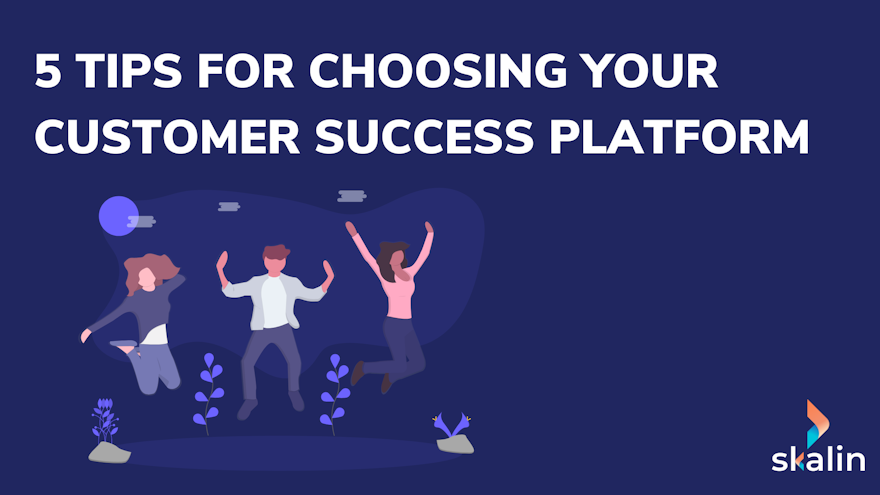360° customer view, Health Scores, Playbooks... by far, all Customer Success Platforms seem to offer the same thing. But what is the reality? What questions should you ask yourself before buying? Why are the prices so different? Here are 5 points to help you make the right decision.
1. Business needs should be your compass
This sounds trivial, but many people don't do it (and it happens to you sometimes!).
The most common pitfall is to go on Google to see what solutions are coming up and ask for a demo after you've had a look around the site. In the demo, the salesperson will blow your mind and reveal features you hadn't even thought of... So you add this feature to your checklist. You may need it in 3 years. Or later. We have a very strong opinion on the matter: if you hadn't thought of it, you don't need it. Don't be dazzled by the glitter!
It is your need that should define your search criteria, not your research that should drive the need. Take the time, even if only for an hour, to formalize your expectations. We're not talking about writing a specification, but simply putting your ideas into perspective: what are your "must-haves" and your "nice-to-haves". This will help you to have a much more critical and objective vision during the presentations, and to ask the right questions.
2. Be ambitious, but start simply!
We are sometimes struck by companies that have not put the fundamentals in place and then, the day they make the decision to implement a platform, want the whole thing. You don't go from a scooter to a Ferrari without being prepared. It is customary to say "who can do more can do less", but in reality it is often "who wants more can do less" because the 5 years vision is paralyzing. You will not be able to anticipate all your future needs; even your present needs will change. Start simply! And build on it when the foundations are robust. This is the best way to get quick results.
3. Identify the resources needed to deploy and maintain the solution
The implementation of a Customer Success Platform can be more or less complex. Data flows, APIs more or less well-thought-out. At Skalin we have taken the option of simplicity: our customers can deploy the solution in a week in parallel with their usual work, with the support of the dev team from 1 to 3 hours.
Next comes the calculation of the Health Score. The calibration of the health score is a key criterion, which is often poorly studied. All platforms offer this, but the methods can be very different. The classic CS Platform approach is based on business rules, i.e. you set the conditions that determine whether an account is healthy or not. We explained in a previous article why we do not believe in the traditional Health Score approach. The point here is to say that this approach is also hyper time-consuming: you have to set up the rules, maintain them and evolve them as soon as a new unanticipated case makes them obsolete. A solution like Skalin, based on an AI, does away with all these settings, which makes it operational more quickly. This approach also makes your score much more reliable and scalable, as it calibrates itself automatically.
Finally, when it comes to resources, there is the issue of ownership and adoption. The sophisticated features that made you dream in pre-sales create complexity. Complexity leads to adoption problems. And without adoption, a product is worthless. At Skalin, we ask ourselves every day how we can make our product simpler to make CSM's everyday life easier.
4. Do a quick evaluation of existing CS Tools
High-touch vs. low-touch: some platforms have focused on automation to simulate the actions of a CSM on a large scale. If you are low-touch, this is probably what you need. If you are high-touch and want to put CSM and your customers back in the game, you will need a platform that puts quality feedback on the same level as the uses of your product. In this case, an approach like Skalin's will probably be more appropriate.
Location: most of the platforms are based in the US, some are European. Take this into account as it has an impact on the times you can reach your contacts.
Beyond localization, there is the approach of the Roadmap. At Skalin we have set up a collaborative Roadmap, which means that each client can send us their feature ideas, and each quarter all the clients vote to choose the features that we will develop in the next 3 months. A fairly sound and logical approach, but quite rare!
5. Don't wait until the last moment to look at prices
There are considerable price differences between CS Platforms. From a few hundred euros per month to several thousand euros. Let's take the hypothesis of a company with a ARR of €2M and wishing to equip a team of 7 people: it will cost you about €18K per year if you equip yourself with ChurnZero, ClientSuccess or Planhat, which is about 3 times the price of a platform like Skalin.

